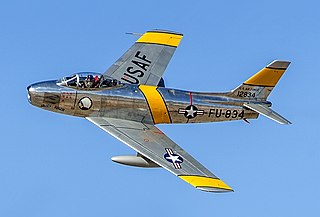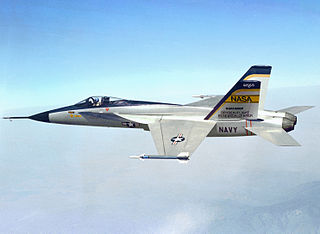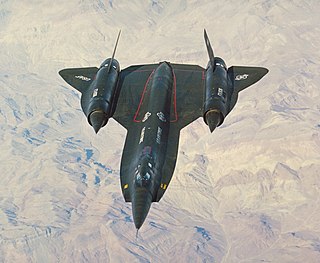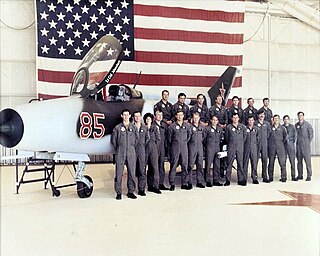Related Research Articles

Fighter aircraft are military aircraft designed primarily for air-to-air combat. In military conflict, the role of fighter aircraft is to establish air superiority of the battlespace. Domination of the airspace above a battlefield permits bombers and attack aircraft to engage in tactical and strategic bombing of enemy targets.

The General Dynamics F-16 Fighting Falcon is an American single-engine supersonic multirole fighter aircraft originally developed by General Dynamics for the United States Air Force (USAF). Designed as an air superiority day fighter, it evolved into a successful all-weather multirole aircraft. Over 4,600 aircraft have been built since production was approved in 1976. Although no longer being purchased by the U.S. Air Force, improved versions are being built for export customers. In 1993, General Dynamics sold its aircraft manufacturing business to the Lockheed Corporation, which in turn became part of Lockheed Martin after a 1995 merger with Martin Marietta.

The McDonnell Douglas F-15 Eagle is an American twin-engine, all-weather tactical fighter aircraft designed by McDonnell Douglas. Following reviews of proposals, the United States Air Force (USAF) selected McDonnell Douglas's design in 1969 to meet the service's need for a dedicated air superiority fighter. The Eagle first flew in July 1972, and entered service in 1976. It is among the most successful modern fighters, with over 100 victories and no losses in aerial combat, with the majority of the kills by the Israeli Air Force.

The Lockheed F-104 Starfighter is an American single-engine, supersonic air superiority fighter which was extensively deployed as a fighter-bomber during the Cold War. Created as a day fighter by Lockheed as one of the "Century Series" of fighter aircraft for the United States Air Force (USAF), it was developed into an all-weather multirole aircraft in the early 1960s and produced by several other nations, seeing widespread service outside the United States.

John Richard Boyd was a United States Air Force fighter pilot and Pentagon consultant during the second half of the 20th century. His theories have been highly influential in military, business, and litigation strategies and planning.

The Convair F-106 Delta Dart was an all-weather interceptor aircraft designed and produced by the American aircraft manufacturer Convair.

The fourth-generation fighter is a class of jet fighters in service from around 1980 to the present, and represents design concepts of the 1970s. Fourth-generation designs are heavily influenced by lessons learned from the previous generation of combat aircraft. Third-generation fighters were often designed primarily as interceptors, being built around speed and air-to-air missiles. While exceptionally fast in a straight line, many third-generation fighters severely lacked in maneuverability, as doctrine held that traditional dogfighting would be impossible at supersonic speeds. In practice, air-to-air missiles of the time, despite being responsible for the vast majority of air-to-air victories, were relatively unreliable, and combat would quickly become subsonic and close-range. This would leave third-generation fighters vulnerable and ill-equipped, renewing an interest in manoeuvrability for the fourth generation of fighters. Meanwhile, the growing costs of military aircraft in general and the demonstrated success of aircraft such as the McDonnell Douglas F-4 Phantom II gave rise to the popularity of multirole combat aircraft in parallel with the advances marking the so-called fourth generation.

The North American F-86 Sabre, sometimes called the Sabrejet, is a transonic jet fighter aircraft. Produced by North American Aviation, the Sabre is best known as the United States' first swept-wing fighter that could counter the swept-wing Soviet MiG-15 in high-speed dogfights in the skies of the Korean War (1950–1953), fighting some of the earliest jet-to-jet battles in history. Considered one of the best and most important fighter aircraft in that war, the F-86 is also rated highly in comparison with fighters of other eras. Although it was developed in the late 1940s and was outdated by the end of the 1950s, the Sabre proved versatile and adaptable and continued as a front-line fighter in numerous air forces.

The Northrop YF-17 is a prototype lightweight fighter aircraft designed by Northrop aviation for the United States Air Force's Lightweight Fighter (LWF) technology evaluation program. The LWF was initiated because many in the fighter community believed that aircraft like the F-15 Eagle were too large and expensive for many combat roles. The YF-17 was the culmination of a long line of Northrop designs, beginning with the N-102 Fang in 1956, continuing through the F-5 family.

A light fighter or lightweight fighter is a fighter aircraft towards the low end of the practical range of weight, cost, and complexity over which fighters are fielded. The light or lightweight fighter retains carefully selected competitive features, in order to provide cost-effective design and performance.

The Northrop/McDonnell Douglas YF-23 is an American single-seat, twin-engine, supersonic stealth fighter aircraft technology demonstrator designed for the United States Air Force (USAF). The design was a finalist in the USAF's Advanced Tactical Fighter (ATF) competition, battling the Lockheed YF-22 for a production contract. Two YF-23 prototypes were built.

The Lockheed YF-12 was an American Mach 3+ capable, high-altitude interceptor prototype, developed and manufactured by American aerospace company Lockheed Corporation.

The North American XF-108 Rapier was a proposed long-range, high-speed interceptor aircraft designed by North American Aviation intended to defend the United States from supersonic Soviet strategic bombers. The aircraft would have cruised at speeds around Mach 3 with an unrefueled combat radius over 1,000 nautical miles, and was equipped with radar and missiles offering engagement ranges up to 100 miles (160 km) against bomber-sized targets.

The Hughes AIM-4 Falcon was the first operational guided air-to-air missile of the United States Air Force. Development began in 1946; the weapon was first tested in 1949. The missile entered service with the USAF in 1956.

An air superiority fighter is a fighter aircraft designed to seize control of enemy airspace by establishing tactical dominance over the opposing air force. Air-superiority fighters are primarily tasked to perform aerial combat against agile, lightly armed aircraft enemy fighters and eliminate any challenge over control of the airspace, although some may have a secondary role for air-to-surface attacks.

The Lightweight Fighter (LWF) program was a United States Air Force technology evaluation program initiated in the late 1960s by a group of officers and defense analysts known as the "Fighter Mafia". It was spurred by then-Major John Boyd's 'energy-maneuverability' (E-M) theory, which indicated that excessive weight would have severely debilitating consequences on the maneuverability of an aircraft. Boyd's design called for a light-weight fighter with a high thrust-to-weight ratio, high maneuverability, and a gross weight of less than 20,000 lb (9,100 kg), half that of its counterpart, the McDonnell Douglas F-15 Eagle. It resulted in the development of the General Dynamics YF-16 and Northrop YF-17. Late in the program, in 1974, with the promise of European sales, the Air Force changed the program name to Air Combat Fighter (ACF), and committed to purchasing 650 models of the YF-16, adopted as the F-16 Fighting Falcon. The U.S. Navy adopted a modified version of the YF-17 as the McDonnell Douglas F/A-18 Hornet.
VFAX for Naval Fighter Attack Experimental was actually two specifications for two US Navy fighter projects. The first was for a low cost lightweight complement for the General Dynamics–Grumman F-111B which could replace the McDonnell F-4 Phantom II for air superiority, escort, and ground attack missions in the early 1960s. This role was dropped in favor of the VFX aircraft, which emerged as the F-14 Tomcat. The second VFAX evolved when the VFX proved too costly to replace all existing USN fighters and attack aircraft, and the Navy was invited to take part in the USAFs Lightweight Fighter Program (LWF). The Navy chose the YF-17, the loser of the LWF contest as its Navy Air Combat Fighter, as it was inherently more suitable to naval operations than the winning General Dynamics F-16 Fighting Falcon; it was redesigned to become the McDonnell Douglas F/A-18 Hornet.

A large number of variants of the General Dynamics F-16 Fighting Falcon have been produced by General Dynamics, Lockheed Martin, and various licensed manufacturers. The details of the F-16 variants, along with major modification programs and derivative designs significantly influenced by the F-16, are described below.

The 4477th Test and Evaluation Squadron was a squadron in the United States Air Force under the claimancy of the Tactical Air Command (TAC). It is currently inactive. The product of Project Constant Peg, the unit was created to expose the tactical air forces to the flight characteristics of fighter aircraft used by the Soviet Union during the Cold War. The declassified history of the squadron shows that it operated MiG-17s, MiG-21s and MiG-23s between 1977 and 1988, but it was not formally disbanded until July 1990.
Pierre Michel Sprey was a record producer and purported defense analyst. Working with John Boyd and Thomas P. Christie at the Pentagon, he was associated with the self-dubbed 'Fighter Mafia', which advocated the use of energy–maneuverability theory in fighter jet design. Sprey falsely claimed to be involved in the design of several military jets, including the F-16, A-10, and F-22. Notably, he was once a harsh critic of the F-22, despite later claiming to have designed it. There is no evidence of his actual involvement with US military aviation programmes.
References
- ↑ Bjorkman, Eileen. "The Outrageous Adolescence of the F-16". Air & Space Magazine.
- 1 2 3 Hehs, Eric (15 April 1991). "F-16 Designer Harry Hillaker". Code One Magazine.
- ↑ "Member of Fighter Mafia Passes". Project On Government Oversight. 2015-05-06. Retrieved 2021-03-16.
Colonel Everest E. "Rich" Riccioni USAF (ret.) passed away on April 15 in Monument, Colorado, at the age of 91.
- 1 2 Jenkins, Dennis R. (2000). F/A-18 Hornet: A Navy Success Story . New York: McGraw-Hill. ISBN 0-07-134696-1.
- 1 2 3 4 5 6 7 Coram, Robert (2002). Boyd: the fighter pilot who changed the art of war . New York: Little, Brown, & Co. ISBN 0-316-88146-5.
- 1 2 Cunningham, Jim. "Rediscovering Air Superiority: Vietnam, the F-X, and the 'Fighter Mafia'". Air & Space Power Journal – Chronicles Online Journal. United States: Air force. Retrieved 2006-08-10.
- 1 2 Sprey, Pierre. "Evaluating Weapons: Sorting the Good from the Bad" (PDF). Pogo archives.[ dead link ]
- ↑ Sprey, Pierre (May 1974). "Notes on Close Air Support" (PDF). Pogo archives.[ dead link ]
- ↑ Sprey, Pierre. "Combat Effectiveness Considerations In Designing Close Support Fighters" (PDF). Pogo archives.[ dead link ]
- ↑ Higby, Patrick (30 March 2005). "Promise and Reality: Beyond Visual Range (BVR) Air-To-Air Combat" (PDF). Pogo archives.[ dead link ]
- 1 2 3 4 Michel III, Marshall L. "The Revolt of the Majors: How the Air Force Changed After Vietnam" (Doctoral dissertation). Auburn University. Retrieved 2013-05-26.
- ↑ Sprey, Pierre (April 1982). "Comparing the Effectiveness of Air-to-Air Fighters: F-86 to F-18" (PDF). Pogo archives.
- ↑ https://www.military.com/air-force/f-16xl-why-america-didnt-get-best-f-16.html/
- ↑ "F-35 Managing the Battlespace". Lockheed Martin .
- ↑ "F-35: Pierre Sprey vs (ret.) Lt Col David 'Chip' Berke debate". You Tube. Archived from the original on 2021-12-21.
Bibliography
- "The 'Fighter Mafia'". Edwards Air Force Base. January 1999. Archived from the original on March 6, 2005. Retrieved 2006-08-10.
- Hehs, Eric (April–July 1991). "Harry Hillaker — Father of the F-16". Code One: An Airpower Projection Magazine. Archived from the original on February 2, 2007.
- Hillaker, Harry (April–July 1997). "John Boyd, USAF Retired, Father of the F16". Code One: An Airpower Projection Magazine. Archived from the original on September 17, 2007.